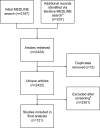Evidence appraisal: a scoping review, conceptual framework, and research agenda
- PMID: 28541552
- PMCID: PMC6259661
- DOI: 10.1093/jamia/ocx050
Evidence appraisal: a scoping review, conceptual framework, and research agenda
Abstract
Objective: Critical appraisal of clinical evidence promises to help prevent, detect, and address flaws related to study importance, ethics, validity, applicability, and reporting. These research issues are of growing concern. The purpose of this scoping review is to survey the current literature on evidence appraisal to develop a conceptual framework and an informatics research agenda.
Methods: We conducted an iterative literature search of Medline for discussion or research on the critical appraisal of clinical evidence. After title and abstract review, 121 articles were included in the analysis. We performed qualitative thematic analysis to describe the evidence appraisal architecture and its issues and opportunities. From this analysis, we derived a conceptual framework and an informatics research agenda.
Results: We identified 68 themes in 10 categories. This analysis revealed that the practice of evidence appraisal is quite common but is rarely subjected to documentation, organization, validation, integration, or uptake. This is related to underdeveloped tools, scant incentives, and insufficient acquisition of appraisal data and transformation of the data into usable knowledge.
Discussion: The gaps in acquiring appraisal data, transforming the data into actionable information and knowledge, and ensuring its dissemination and adoption can be addressed with proven informatics approaches.
Conclusions: Evidence appraisal faces several challenges, but implementing an informatics research agenda would likely help realize the potential of evidence appraisal for improving the rigor and value of clinical evidence.
Keywords: clinical research informatics; critical appraisal; journal clubs; journal comments; post-publication peer review.
© The Author 2017. Published by Oxford University Press on behalf of the American Medical Informatics Association. All rights reserved. For Permissions, please email: journals.permissions@oup.com
Figures




Similar articles
-
Beyond the black stump: rapid reviews of health research issues affecting regional, rural and remote Australia.Med J Aust. 2020 Dec;213 Suppl 11:S3-S32.e1. doi: 10.5694/mja2.50881. Med J Aust. 2020. PMID: 33314144
-
Analysis of evidence appraisals for interventional studies in family medicine using an informatics approach.Prim Health Care Res Dev. 2019 Aug 22;20:e123. doi: 10.1017/S1463423619000264. Prim Health Care Res Dev. 2019. PMID: 31434596 Free PMC article.
-
Translational research in medical informatics or from theory to practice. A call for an applied informatics journal.Methods Inf Med. 2008;47(1):1-3. Methods Inf Med. 2008. PMID: 18213421
-
The Role of Artificial Intelligence Model Documentation in Translational Science: Scoping Review.Interact J Med Res. 2023 Jul 14;12:e45903. doi: 10.2196/45903. Interact J Med Res. 2023. PMID: 37450330 Free PMC article.
-
A scoping review of 'big data', 'informatics', and 'bioinformatics' in the animal health and veterinary medical literature.Anim Health Res Rev. 2019 Jun;20(1):1-18. doi: 10.1017/S1466252319000136. Anim Health Res Rev. 2019. PMID: 31895022
Cited by
-
Construction of a Different Polymer Chain Structure to Study π-π Interaction between Polymer and Reduced Graphene Oxide.Polymers (Basel). 2018 Jun 29;10(7):716. doi: 10.3390/polym10070716. Polymers (Basel). 2018. PMID: 30960641 Free PMC article.
-
AI-generated text may have a role in evidence-based medicine.Nat Med. 2023 Jul;29(7):1593-1594. doi: 10.1038/s41591-023-02366-9. Nat Med. 2023. PMID: 37221382 Free PMC article.
-
A comment-driven evidence appraisal approach to promoting research findings into practice when only uncertain evidence is available.Health Res Policy Syst. 2023 Mar 27;21(1):25. doi: 10.1186/s12961-023-00969-9. Health Res Policy Syst. 2023. PMID: 36973785 Free PMC article.
-
Understanding the nature and scope of clinical research commentaries in PubMed.J Am Med Inform Assoc. 2020 Mar 1;27(3):449-456. doi: 10.1093/jamia/ocz209. J Am Med Inform Assoc. 2020. PMID: 31889182 Free PMC article.
-
The voices of children and young people during COVID-19: A critical review of methods.Acta Paediatr. 2022 Sep;111(9):1670-1681. doi: 10.1111/apa.16422. Epub 2022 Jun 12. Acta Paediatr. 2022. PMID: 35608994 Free PMC article. Review.
References
-
- Chalmers I, Bracken MB, Djulbegovic B. et al. How to increase value and reduce waste when research priorities are set. Lancet. 2014;3839912:156–65. - PubMed
-
- Wooding S, Pollitt A, Castle-Clark S. et al. Mental Health Retrosight: Understanding the Returns from Research (Lessons from Schizophrenia): Policy Report. RAND Corporation; 2013. http://www.rand.org/content/dam/rand/pubs/research_reports/RR300/RR325/R.... Accessed May 12, 2017. - PMC - PubMed
-
- Wooding S, Hanney S, Buxton M, Grant J. The Returns from Arthritis Research Volume 1: Approach, Analysis and Recommendations. RAND Corporation; 2004. http://www.rand.org/pubs/monographs/MG251.html. Accessed May 12, 2017.
-
- Wooding S, Hanney S, Pollitt A, Buxton M, Grant J. Project Retrosight: Understanding the returns from cardiovascular and stroke research: The Policy Report. RAND Corporation; 2011. http://www.rand.org/pubs/working_papers/WR836.html. Accessed May 12, 2017. - PMC - PubMed
Publication types
MeSH terms
Grants and funding
LinkOut - more resources
Full Text Sources
Other Literature Sources

